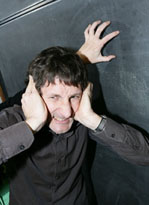 A shot in the dark - testing acoustics 1960's style in the Royal Festival Hall
A shot in the dark - testing acoustics 1960's style in the Royal Festival HallAn innovative technique that, for the first time, accurately measures exactly how sound behaves in 'real-world' situations is now under development - and could improve acoustics in buildings ranging from concert halls to railway stations.
The potential impact of the technique, which could also assist in the development of more effective hearing aids, will be described at this year's BA Festival of Science in Norwich.
The technique is designed to pinpoint precisely how indoor environments respond to music and speech while those areas are in everyday use. This opens up the prospect of basing acoustic design on more realistic information about the way sound behaves than has previously been possible. It may also contribute to the development of hearing aids that adapt the way they process sound according to the acoustic environment they are in, providing a much better listening experience for hearing aid users than is currently achievable.
The conventional way of measuring acoustics has been to make a short blast of noise (e.g. a gunshot), record it and analyse how it dies away (or 'decays'). The noise has to be very loud so that the environment's effect on it can be assessed across the full range of sound, from very loud to very quiet - only in this way can comprehensive information on an environment's acoustic performance be obtained. However, gunshot noise poses a risk to hearing and is unpleasant to listen to. This means that measurements taken in unoccupied areas are the norm even though these do not accurately indicate 'real' acoustic performance - when people are present, moving and talking etc.
Now, engineers at the University of Salford are exploring whether music played at an average level of audibility, or even the conversation of people in the indoor environment being tested, could be used instead of the loud, short blast of noise. The work is being funded by the Engineering and Physical Sciences Research Council (EPSRC).
 Exploiting the major advances in computing power and sophistication achieved in the IT sector in recent years, the team is developing groundbreaking computer programmes capable of isolating snippets or phrases from normal music or speech, analysing their decay and extrapolating this data so it provides an accurate indication of an environment's effect on sound. Since loud test sounds are not required, this approach avoids the need to vacate the environment when testing takes place, enabling more realistic acoustic data to be gathered.
Exploiting the major advances in computing power and sophistication achieved in the IT sector in recent years, the team is developing groundbreaking computer programmes capable of isolating snippets or phrases from normal music or speech, analysing their decay and extrapolating this data so it provides an accurate indication of an environment's effect on sound. Since loud test sounds are not required, this approach avoids the need to vacate the environment when testing takes place, enabling more realistic acoustic data to be gathered. Trevor Cox, Professor of Acoustic Engineering at Salford University, is leading this pioneering research and will be discussing progress at the BA Festival on 8th September.
"Our work could deliver a step-change in understanding how rooms behave acoustically," says Professor Cox. "It could help eliminate a lot of guesswork on the effect that actual usage of indoor environments will have on their acoustics."
The research could lead to changes within around 5-10 years in the way that indoor environments are designed and constructed. In visual terms, most changes are unlikely to be obvious.
"The key differences could be in altering the way that building materials absorb or reflect sound by treating them prior to incorporation in a building," says Professor Cox. "There's a long way to go but the potential impact, in terms of improving quality of life for millions of people, is obvious."
Notes for Editors
The 3-year research project "Room Acoustic Parameters from Music" is due to run until summer 2007 and is receiving EPSRC funding of around £130,000.
This year's BA (British Association for the Advancement of Science) Festival of Science takes place in Norwich from 2nd - 9th September. Hosted by Norwich Research Park, the overall theme is 'People, Science and Society'. The event is one of the UK's biggest science festivals and attracts around 400 of the best scientists and science communicators from home and abroad who reveal the latest developments in research to a general audience. For more information, visit www.the-ba.net.
Professor Trevor Cox will be talking about "Architectural Sound Matters" at 14.30 on Friday 8th September at LT3, Lecture Theatre building. Professor Cox will also be taking part in a press conference at 9am at the BA Festival on 8th September where he will be discussing his work.
The Engineering and Physical Sciences Research Council (EPSRC) is the UK's main agency for funding research in engineering and the physical sciences. The EPSRC invests more than £575 million a year in research and postgraduate training, to help the nation handle the next generation of technological change. The areas covered range from information technology to structural engineering, and mathematics to materials science. This research forms the basis for future economic development in the UK and improvements for everyone's health, lifestyle and culture. EPSRC also actively promotes public awareness of science and engineering. EPSRC works alongside other Research Councils with responsibility for other areas of research. The Research Councils work collectively on issues of common concern via Research Councils UK.

